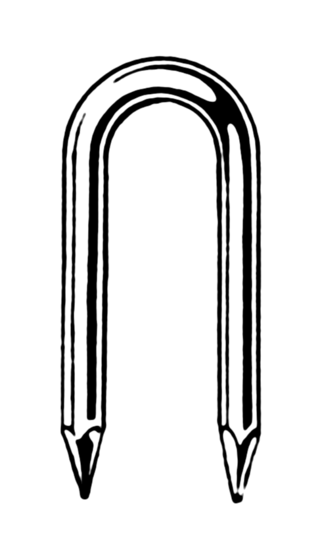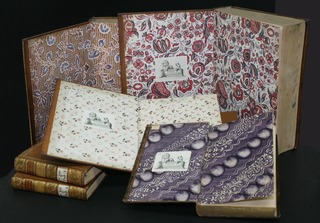Binder may refer to:
Binder may refer to:
Link or Links may refer to:
Binding may refer to:

A paper clip is a tool used to hold sheets of paper together, usually made of steel wire bent to a looped shape. Most paper clips are variations of the Gem type introduced in the 1890s or earlier, characterized by the one and a half loops made by the wire. Common to paper clips proper is their utilization of torsion and elasticity in the wire, and friction between wire and paper. When a moderate number of sheets are inserted between the two "tongues" of the clip, the tongues will be forced apart and cause torsion in the bend of the wire to grip the sheets together. They are usually used to bind papers together for productivity and portability.

A staple is a type of two-pronged fastener, usually metal, used for joining, gathering, or binding materials together. Large staples might be used with a hammer or staple gun for masonry, roofing, corrugated boxes and other heavy-duty uses. Smaller staples are used with a stapler to attach pieces of paper together; such staples are a more permanent and durable fastener for paper documents than the paper clip.

A stapler is a mechanical device that joins pages of paper or similar material by driving a thin metal staple through the sheets and folding the ends. Staplers are widely used in government, business, offices, workplaces, homes, and schools.

Library binding can be divided into the two major categories of "original" and "after market". The original category is as it says: the book was originally bound with the idea that it would be used in a library setting where the book would receive harder use than those usual trade editions sold to the public.

The term dispenser typically imply a machine or container which is designed to release a specific amount of its content, usually liquids or powders/fine granular materials.

A hole punch, also known as hole puncher, or paper puncher, is an office tool that is used to create holes in sheets of paper, often for the purpose of collecting the sheets in a binder or folder. A hole punch can also refer to similar tools for other materials, such as leather, cloth, or sheets of plastic or metal.

A binder clip is a simple device for binding sheets of paper together. It leaves the paper intact and can be removed quickly and easily, unlike the staple.
Imposition is one of the fundamental steps in the prepress printing process. It consists of the arrangement of the printed product's pages on the printer's sheet, in order to obtain faster printing, simplify binding and reduce paper waste.

Ring binders are large folders that contain file folders or hole punched papers. These binders come in various sizes and can accommodate an array of paper sizes. These are held in the binder by circular or D-shaped retainers, onto which the contents are threaded. In North America, the rings themselves come in a variety of sizes, including 0.5, 1, 1.5, and 2 inches, though other sizes are also available. The rings may be secured by lever arch mechanisms or other securing systems. The binders themselves are typically made from plastic with metal rings. Early designs were patented during the late 19th century.
Clip or CLIP may refer to:

A file folder is a kind of folder that holds papers together for organization and protection. File folders usually consist of a sheet of heavy paper stock or other thin, but stiff, material which is folded in half, and are used to keep paper documents. They are often used in conjunction with a filing cabinet for storage. File folders can easily be purchased at office supplies stores.
A binder or binding agent is any material or substance that holds or draws other materials together to form a cohesive whole mechanically, chemically, by adhesion or cohesion.
Bind or BIND may refer to:

Bindery refers to a studio, workshop or factory where sheets of (usually) paper are fastened together to make books, but also where gold and other decorative elements are added to the exterior of books, where boxes or slipcases for books are made and where the restoration of books is carried out.

The endpapers or end-papers of a book are the pages that consist of a double-size sheet folded, with one half pasted against an inside cover, and the other serving as the first free page. Thus, the front endpapers precede the title page and the text, whereas the back endpapers follow the text. Booksellers sometimes refer to the front endpaper as FEP.
Template may refer to:

Bookbinding is the process of building a book, usually in codex format, from an ordered stack of paper sheets with one's hands and tools, or in modern publishing, by a series of automated processes. Firstly, one binds the sheets of papers along an edge with a thick needle and strong thread. One can also use loose-leaf rings, binding posts, twin-loop spine coils, plastic spiral coils, and plastic spine combs, but they last for a shorter time. Next, one encloses the bound stack of paper in a cover. Finally, one places an attractive cover onto the boards, and features the publisher's information and artistic decorations.

Paper chemicals designate a group of chemicals that are used for paper manufacturing, or modify the properties of paper. These chemicals can be used to alter the paper in many ways, including changing its color and brightness, or by increasing its strength and resistance to water. The chemicals can be defined on basis of their usage in the process.